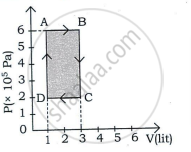Advertisements
Advertisements
Question
In a petrol engine, (internal combustion engine) air at atmospheric pressure and temperature of 20°C is compressed in the cylinder by the piston to `1/8` of its original volume. Calculate the temperature of the compressed air. (For air γ = 1.4)
Solution
T1 = 20°C = 20 + 273 = 293 K
V1 = 1 m3
V2 = `1/8` V1m3
γ = 1.4
From equation of adiabatic process
TVγ − 1 = constant
`"T"_1"V"_1^(γ - 1) = "T"_2"V"_2^(γ - 1)`
T2 = `("V"_1/"V"_2)^(γ - 1)"T"_1`
T2 = `[1/((1/8))]^(1.4 - 1) xx 293`
= (8)0.4 × 293
= 673.1 K
= 673.1 − 273
T2 ≅ 400°C
APPEARS IN
RELATED QUESTIONS
Explain why The climate of a harbour town is more temperate than that of a town in a desert at the same latitude.
Give an example of some familiar process in which heat is added to an object, without changing its temperature.
Explain the thermodynamics of the isochoric process.
When food is cooked in a vessel by keeping the lid closed, after some time the steam pushes the lid outward. By considering the steam as a thermodynamic system, then in the cooking process
When you exercise in the morning, by considering your body as a thermodynamic system, which of the following is true?
Give the equation of state for an isothermal process.
Give an equation state for an isochoric process.
An ideal gas is made to go from a state A to stale B in the given two different ways (see figure) (i) an isobaric and then an isochoric process and (ii) an isochoric and then an isobaric process. The work done by gas in the two processes are W1 and W2 respectively. Then,

Two identical samples of a gas are allowed to expand (i) isothermally (ii) adiabatically. Work done is ____________.
An ideal gas is taken through a cyclic process ABCDA as shown in figure. The net work done by the gas during the cycle is ______.

